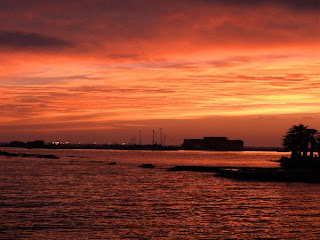The old walled city of Lefkosia is unique and definitely the place to head for first. Encircled by strong fortress walls built by the Venetians in the 16th century, the enchanting old city is scattered with buildings and monuments of historical interest as well as shops, cafes and tavernas. Its pedestrian section, "Laiki Geitonia", has been carefully renovated to evoke the atmoshphere of past days.
In the countryside you’ll find ruins of the ancient city kingdoms of Idalion and Tamasos near the villages of Dali and Politiko respectively. One may also visit the Fikardou village which has been declared as a monument and was awarded the Europa Nostra award in 1987.

Larnaca
Larnaka, one of the oldest continuously inhabited cities in the world, is the modern gateway to
As the home of the island's main international airport, Larnaka offers many visitors their first taste of
Further west at Kiti village is

Limassol (Lemosos)
Lemesos is a lively and cosmopolitan resort located on the coast of the
In the heart of the city itself you’ll find the
Some 19 kilometres west of Lemesos, is Kourion, one of the most impressive archaeological sites not just in

Paphos
Paphos boasts a number of unique claims to fame: it was here that Aphrodite, goddess of love, walked in from the sea to found a thousand love cults across the Hellenic world. It was here that Agapeanor, leader of the Arcadian contingent to Troy, was shipwrecked and it was also here that St Paul stopped off on his way to Rome for a quick conversion of the local proconsul.
Paphos is a city where myth and reality mingle freely and where you can see Roman villas, Byzantine churches and Crusader castles within a few minutes walk of the harbour. It is also a city that is facing similar developmental pressures to the rest of Cyprus, although it does enjoy some protection as a UNESCO world heritage site.
Paphos sprawls above the old harbour area in a haphazard fashion; contemporary hotels mingle with ancient buildings as they climb an escarpment first settled by the Byzantines in the first century AD. Traditionally two settlements made up Paphos: Kato Pafos (the harbour area) and Ktima (the hill), but these have recently merged as high-rises fill in the gaps in-between the two.
The airport nearby means that the city is easily accessible and its location as the gateway to the less developed north (and the untouched Akamas peninsula) has also attracted visitors.
Know More About Paphos

Troodos
The impressive Troodos mountain range stretches across most of the western side of Cyprus, offering cool sanctuary and idyllic hours spent in long walks in its scented pine forests in summer and winter sports and ski-ing in winter.
Here are the many famous mountain resorts, Byzantine monasteries and churches on mountain peaks, and nestling in its valleys and picturesque mountain villages clinging to terraced hill slopes.
The area has been known since ancient times for its mines, and in the Byzantine period it became a great centre of Byzantine art, as churches and monasteries were built in the mountains, away from the threatened coastline.
The Cyprus Tourism Organisation has a leaflet for the unique Nature Walks, which have been created by the Forestry Department in co-operation wlth the Cyprus Tourism Organisation at Troodos itself, with full details of the rich profusion of flora and fauna found on these very attractive walks, which attract many visitors every year.
In the Troodos mountain range, besides Machairas to the east, and the actual Troodos district around Mount Olympus (height 1951 metres), there are four other districts, each of which has its own character and separate charm. These districts are: 1. Pitsillia to the east of Mount Olympus, the 2. Solea Valley and the 3. Marathassa Valley to the north of Mount Olympus, and the 4. Krassochoria (the Wine Villages) to the south (north-west of the Limassol district).
These districts are easy to reach from either Limassol or Nicosia.
Related Links…
http://visitingcyprus.blogspot.com/
http://myamazingindiaa.blogspot.com/
http://visitinglondoncity.blogspot.com/
http://visitingistanbulcity.blogspot.com/
http://visitnewsevenwonders.blogspot.com/












